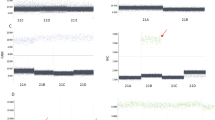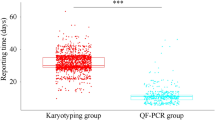Abstract
Rapid diagnosis of common chromosome aneuploidies in raised risk pregnancies, usually prior to full karyotype analysis, is now carried out in a number of European genetic centres; several techniques for detecting genomic copy number changes have been described. Prenatal diagnosis of genetic disease requires accurate and robust assays; the invasive procedures are associated with a risk of pregnancy loss and an abnormal result may lead to termination of the pregnancy. The testing of prenatal material (amniotic fluid, chorionic villi or, more rarely, fetal blood) is associated with specific problems, including the quality and quantity of the tissue and difficulties of interpretation due to phenomena such as maternal cell contamination and mosaicism. In addition, there are 24-h, high-throughput demands on centres offering such a service. The extent to which existing and proposed strategies, including different PCR-based assays, a multiplex ligation-dependent probe amplification approach, and microarrays, fulfil the requirements of rapid prenatal testing is discussed. In the past 3 years, we have tested 7720 prenatal samples for trisomies 13, 18 and 21 using a quantitative fluorescence-PCR (QF-PCR) approach. The abnormality rate was 5.7%. There were no misdiagnoses for nonmosaic trisomy, the amplification failure rate was 0.09% of samples, and 97% of samples received a report on the working day following sample receipt. Maternal cell contamination and mosaicism were also detected. Our data recommend a QF-PCR approach as the current method of choice for rapid aneuploidy testing.
Similar content being viewed by others
Log in or create a free account to read this content
Gain free access to this article, as well as selected content from this journal and more on nature.com
or
References
NEQAS: National External Quality Assessment Scheme in Clinical Cytogenetics; Annual Report: 2000.
Smith K, Lowther G, Maher E, Hourihan T, Wilkinson T, Wolstenholme J : The predictive value of findings of the common aneuploidies, trisomies 13, 18 and 21, and numerical sex chromosome abnormalities at CVS: experience from the ACC U.K. Collaborative Study. Association of Clinical Cytogeneticists Prenatal Diagnosis Working Party. Prenat Diagn 1999; 19: 817–826.
Klinger K, Landes G, Shook D et al: Rapid detection of chromosome aneuploidies in uncultured amniocytes by using fluorescence in situ hybridization (FISH). Am J Hum Genet 1992; 51: 55–65.
Tepperberg J, Pettenati MJ, Rao PN et al: Prenatal diagnosis using interphase fluorescence in situ hybridization (FISH): 2-year multi-center retrospective study and review of the literature. Prenat Diagn 2001; 21: 293–301.
Mansfield ES : Diagnosis of Down syndrome and other aneuploidies using quantitative polymerase chain reaction and small tandem repeat polymorphisms. Hum Mol Genet 1993; 2: 43–50.
Pertl B, Yau SC, Sherlock J, Davies AF, Mathew CG, Adinolfi M : Rapid molecular method for prenatal detection of Down's syndrome. Lancet 1994; 343: 1197–1198.
Levett LJ, Liddle S, Meredith R : A large-scale evaluation of amnio-PCR for the rapid prenatal diagnosis of fetal trisomy. Ultrasound Obstet Gynecol 2001; 17: 115–118.
Bili C, Divane A, Apessos A et al: Prenatal diagnosis of common aneuploidies using quantitative fluorescent PCR. Prenat Diagn 2002; 22: 360–365.
Mann K, Fox SP, Abbs SJ et al: Development and implementation of a new rapid aneuploidy diagnostic service within the UK National Health Service and implications for the future of prenatal diagnosis. Lancet 2001; 358: 1057–1061.
Cirigliano V, Lewin P, Szpiro-Tapies S, Fuster C, Adinolfi M : Assessment of new markers for the rapid detection of aneuploidies by quantitative fluorescent PCR (QF-PCR). Ann Hum Genet 2001; 65: 421–427.
Schmidt W, Jenderny J, Hecher K et al: Detection of aneuploidy in chromosomes X, Y, 13, 18 and 21 by QF-PCR in 662 selected pregnancies at risk. Mol Hum Reprod 2000; 6: 855–860.
Donaghue C, Roberts A, Mann K, Ogilvie CM : Development and targeted application of a rapid QF-PCR test for sex chromosome imbalance. Prenat Diagn 2003; 23: 201–210.
Mann K, Donaghue C, Ogilvie CM : In vivo somatic microsatellite mutations identified in non-malignant human tissue. Hum Genet 2003; 114: 110–114.
Hulten MA, Dhanjal S, Pertl B : Rapid and simple prenatal diagnosis of common chromosome disorders: advantages and disadvantages of the molecular methods FISH and QF-PCR. Reproduction 2003; 126: 279–297.
Liehr T, Beensen V, Hauschild R et al: Pitfalls of rapid prenatal diagnosis using the interphase nucleus. Prenat Diagn 2001; 21: 419–421.
Liehr T, Schreyer I, Neumann A et al: Two more possible pitfalls of rapid prenatal diagnostics using interphase nuclei. Prenat Diagn 2002; 22: 497–499.
Weremowicz S, Sandstrom DJ, Morton CC, Niedzwiecki CA, Sandstrom MM, Bieber FR : Fluorescence in situ hybridization (FISH) for rapid detection of aneuploidy: experience in 911 prenatal cases. Prenat Diagn 2001; 21: 262–269.
Yu C, Bofill B : False negative interphase FISH assay on three prenatal cases of trisomy 18. Am J Hum Genet 2003; 73: 601.
Singh-Kahlon PD, Gadi I, Tepperberg J et al: Conflicting results between prenatal interphase FISH & G-banded chromosome diagnoses: implications for clinical decisions. Am J Hum Genet 2003; 73: 312.
Lee HH, Chang JG, Lin SP, Chao HT, Yang ML, Ng HT : Rapid detection of trisomy 21 by homologous gene quantitative PCR (HGQ-PCR). Hum Genet 1997; 99: 364–367.
Deutsch S, Choudhury U, Sylvan A, Antonarakis SE : Detection of trisomy 21 and other aneuploidies by Paralogous gene quantification. Am J Hum Genet 2003; 73: 318.
Rahil H, Solassol J, Philippe C, Lefort G, Jonveaux P : Rapid detection of common autosomal aneuploidies by quantitative fluorescent PCR on uncultured amniocytes. Eur J Hum Genet 2002; 10: 462–466.
Zimmermann B, Holzgreve W, Wenzel F, Hahn S : Novel real-time quantitative PCR test for trisomy 21. Clin Chem 2002; 48: 362–363.
Ogilvie CM : Prenatal diagnosis for chromosome abnormalities: past, present and future. Pathol Biol (Paris) 2003; 51: 156–160.
Schouten JP, McElgunn CJ, Waaijer R, Zwijnenburg D, Diepvens F, Pals G : Relative quantification of 40 nucleic acid sequences by multiplex ligation-dependent probe amplification. Nucleic Acids Res 2002; 30: e57.
Slater HR, Bruno DL, Ren H, Pertile M, Schouten JP, Choo KH : Rapid, high throughput prenatal detection of aneuploidy using a novel quantitative method (MLPA). J Med Genet 2003; 40: 907–912.
Carter NP, Fiegler H, Piper J : Comparative analysis of comparative genomic hybridization microarray technologies: report of a workshop sponsored by the Wellcome Trust. Cytometry 2002; 49: 43–48.
Rauen KA, Norton ME, Segraves R et al: Array comparative genomic hybridization: applications in genetic medicine. Am J Hum Genet 2003; 73: 204.
Pestova E, Ruffalo T, Marble T, Kucas M, Wilber K, King W : Reproducibility and performance of Vysis GSA300 platform for pre- and post-natal array-based CGH diagnostics. Am J Hum Genet 2003; 73: 310.
Leung WC, Lau ET, Lao TT, Tang MH : Can amnio-polymerase chain reaction alone replace conventional cytogenetic study for women with positive biochemical screening for fetal Down syndrome? Obstet Gynecol 2003; 101: 856–861.
Acknowledgements
We acknowledge the technical assistance of Alysia Hallam, and the contribution of the Cytogenetics Department Prenatal Team.
Author information
Authors and Affiliations
Corresponding author
Rights and permissions
About this article
Cite this article
Mann, K., Donaghue, C., Fox, S. et al. Strategies for the rapid prenatal diagnosis of chromosome aneuploidy. Eur J Hum Genet 12, 907–915 (2004). https://doi.org/10.1038/sj.ejhg.5201224
Received:
Revised:
Accepted:
Published:
Issue date:
DOI: https://doi.org/10.1038/sj.ejhg.5201224
Keywords
This article is cited by
-
Medical Genetics for Practicing Obstetrician
The Journal of Obstetrics and Gynecology of India (2020)
-
Prenatal diagnosis of 4953 pregnant women with indications for genetic amniocentesis in Northeast China
Molecular Cytogenetics (2019)
-
Molecular analysis of miscarriage products using multiplex ligation-dependent probe amplification (MLPA): alternative to conventional karyotype analysis
Archives of Gynecology and Obstetrics (2015)
-
The combined QF-PCR and cytogenetic approach in prenatal diagnosis
Molecular Biology Reports (2014)
-
Array CGH as a first line diagnostic test in place of karyotyping for postnatal referrals - results from four years’ clinical application for over 8,700 patients
Molecular Cytogenetics (2013)



